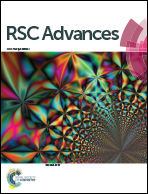Synthesis of high-purity CuO nanoleaves and analysis of their ethanol gas sensing properties†
Abstract
CuO nanocrystals with as-designed morphologies such as uniform quasi-spherical nanoparticles and high-purity nanoleaves were synthesized by adjusting the addition of sodium hydroxide and hydrazine hydrate in aqueous solution at room temperature (25 °C). The increase of sodium hydroxide would accelerate the reaction rate and favor the nucleation of CuO nanocrystals. The decrease of the surface energy will promote the oriented attachment of nanocrystallites along the [−111] direction into nanowires and the final formation of two dimensional (2D) nanoleaves. Increasing the quantity of hydrazine hydrate could decrease the solution system energy and promote the aggregation of CuO nanocrystals from 2D nanoleaves into 3D quasi-spherical nanoparticles. All the CuO nanocrystals with different morphologies were characterized via transmission electron microscopy (TEM), field emission scanning electron microscopy (FESEM) and X-ray diffraction (XRD). The CuO nanoleaves exhibit excellent gas sensing performance in response to ethanol, showing the strongest response value of 8.22 at 1500 ppm ethanol for ∼260 °C.


 Please wait while we load your content...
Please wait while we load your content...